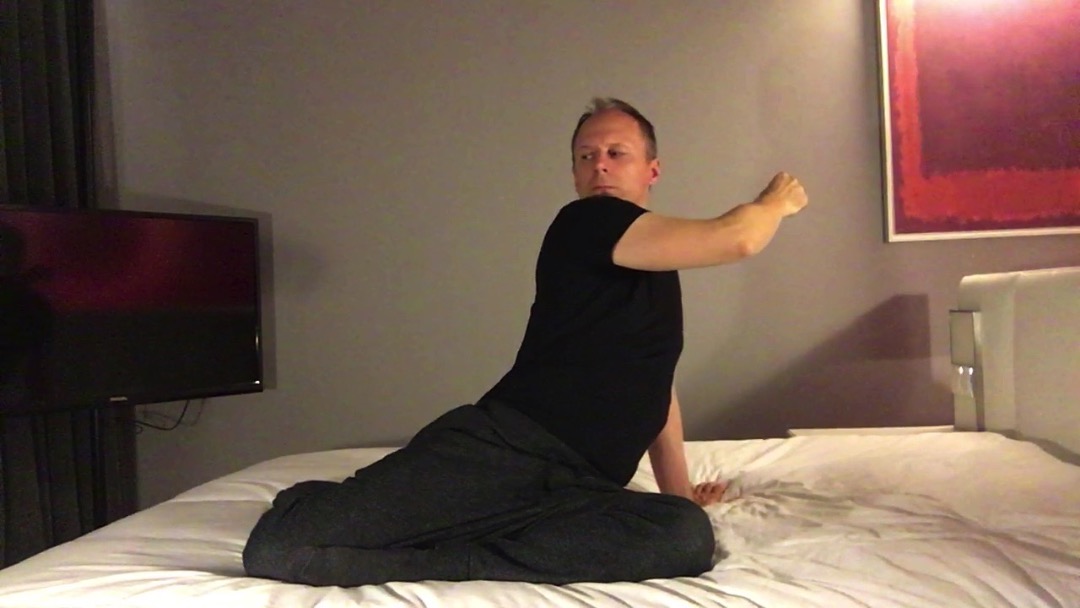Twist to the left in side-sitting (part 1)
The iconic starting position of this lesson is in side-sitting, with the left leg bent in front of you, the right leg bent behind. You lean on your left hand and have the right hand in front of your face. While you turn and then stay turned to the left, you do differentiating movements by turning only your eyes and/or your head; movements of the pelvis in relation to the head; side-bending; flexion and extension of the whole spine. To „twist” here means to move with a turning motion, to form into a spiral shape.
This lesson helps refining the kinesthetic sensations, making them more sensitive and differentiated. You improve your perception of minute changes. This brings improvement of your action in general, in all aspects of moving, thinking, feeling sensing. By finding mobility throughout the spine, in places that are hard to access otherwise, every case of scoliosis can be improved at least slightly.
twistside-sitting twist_in_side_sitting_1
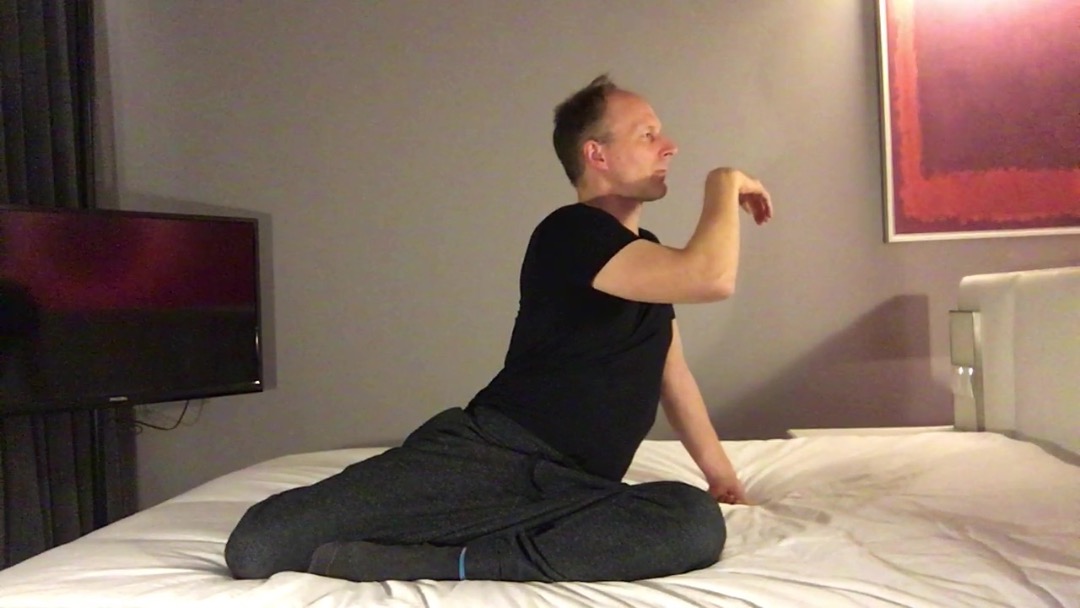
Seated in a side-sitting position, with your left leg bent in front of your pelvis, your right leg bent backwards, your shoulders parallel to a wall in front of you. Your right hand is in front of your face, your elbow hanging and wrist relaxed. Look at your hand.
Turn left, find a reference point
First turn only a little bit to the right, then to the left, many times, find where it is easy.
- The start position already suggests the turn to the left. Don't turn at once, but ease into it. Don't force yourself to turn left, but make small movements. Do this many times.
Stop where it starts to be difficult. Mark that point in front of your nose for future reference.
Turn left, find a reference point
First turn only a little bit to the right, then to the left, many times, find where it is easy.
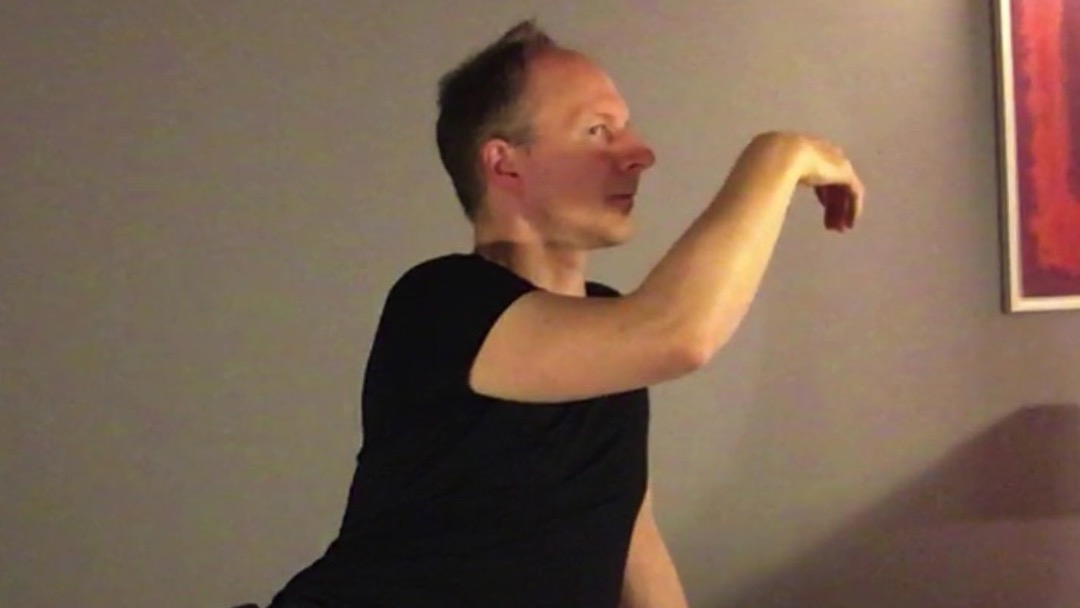
Seated twist to the left, at the reference point.
Eyes to the right, head stays
Starting from the reference position, move your eyes to the right and back to your hand.
- Focus on the movement of your eyes, fluent, simple, slow. Keep breathing in an even, unexcited fashion.
Do not turn your head to the right, only your eyes. This is a differentiating movement with your eyes.
Eyes to the right, head stays
Starting from the reference position, move your eyes to the right and back to your hand.
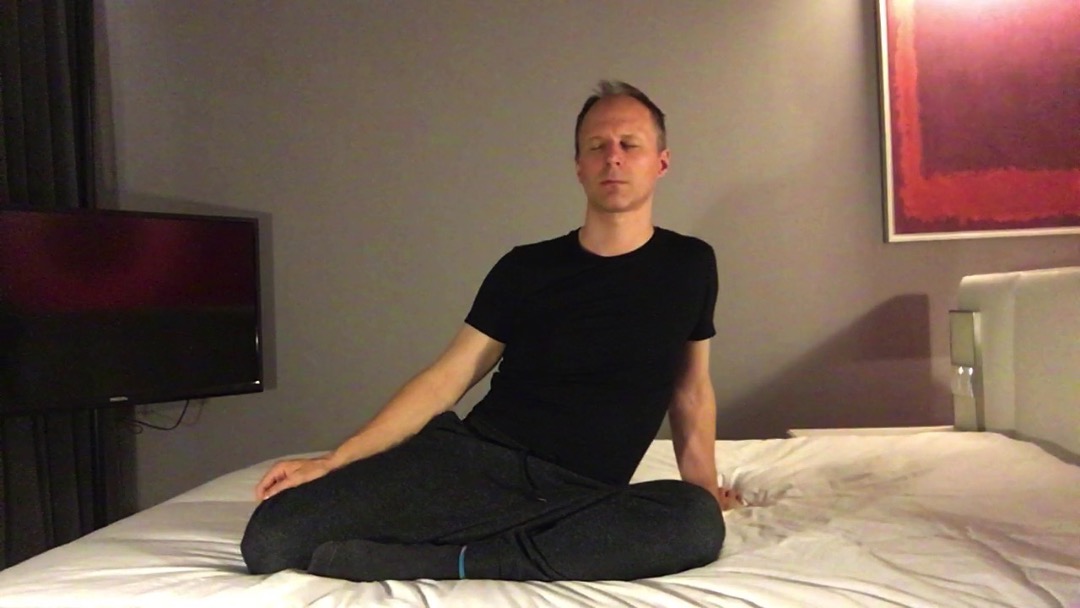
Start position in side-sitting, facing the wall in front of you, with closed eyes
Recall the easiest movements
In your mind and kinestetic thinking, recall the previous movements of turning.
- Think about the small and very, very light movements, recall how they feel like.
Recall the easiest movements
In your mind and kinestetic thinking, recall the previous movements of turning.
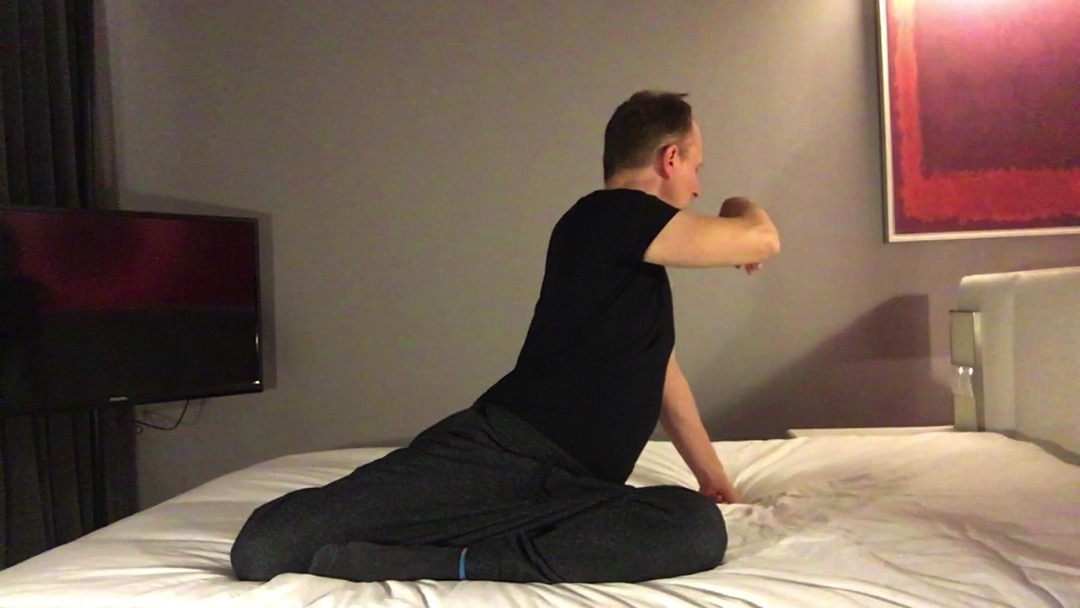
Start position in side-sitting, facing the wall, with closed eyes
Reference movement
Turn left in the lightest way
With your eyes closed, and your hand in front of your face, turn to the left. See how far you go.
- Then lie down and try to make sense of how moving the eyes in the opposite direction (the right) made the actual movement of turning to the left easier and larger.
Reference movement
Turn left in the lightest way
With your eyes closed, and your hand in front of your face, turn to the left. See how far you go.
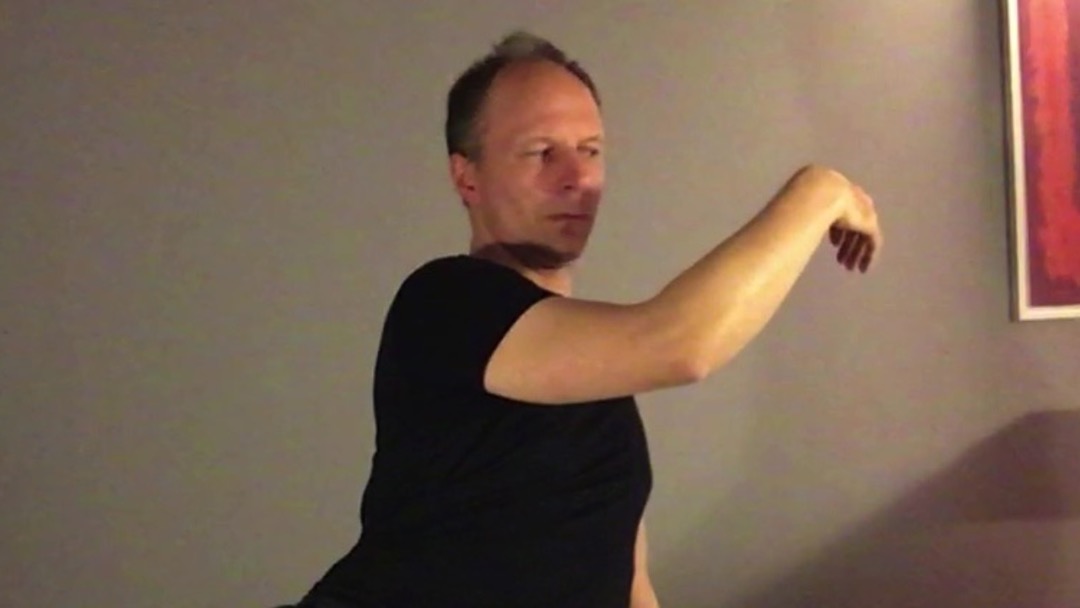
Seated twist to the left, at the reference point.
Head to the right, eyes stay
Starting from the reference position, turn your head to the right and back to your hand. Keep your eyes fixed on your hand.
- Do not turn your eyes to the right, only your head. This is a differentiating movement with your neck.
If it helps, you can think about your nose turning to the right.
Head to the right, eyes stay
Starting from the reference position, turn your head to the right and back to your hand. Keep your eyes fixed on your hand.
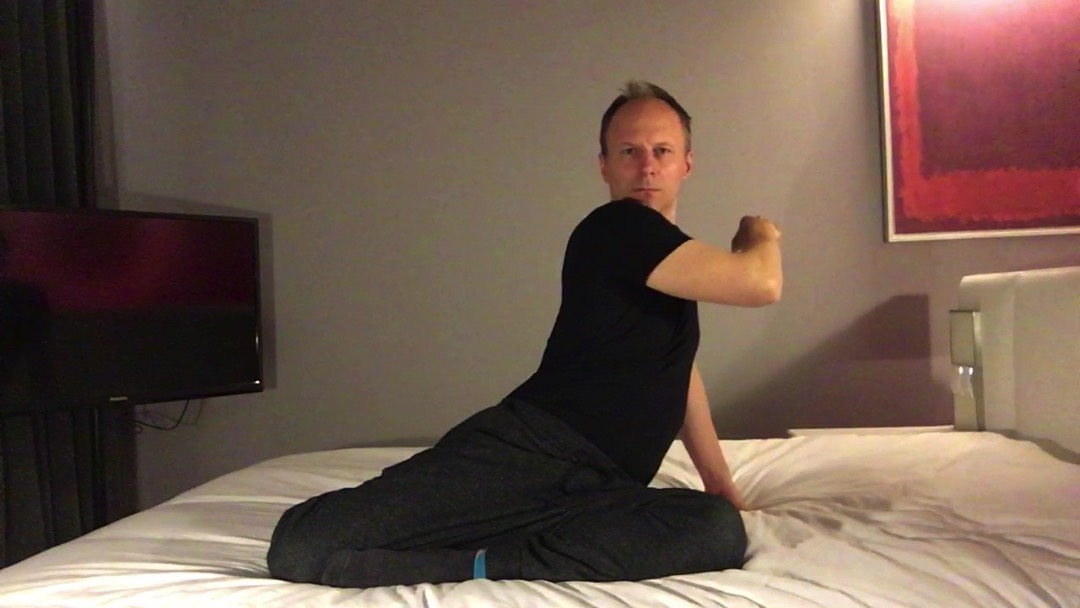
Seated twist to the left, at the reference point.
Review: Head, eyes, breath, don't shrink
Think of being at ease and at full length from the floor up to the top of your head.
- Go through the previous movements again. Breath at ease. Length means neither side of yours is unnecessarily shortened.
Take breaks as you need them, lower your hand, and then lift it again in front of your face.
Review: Head, eyes, breath, don't shrink
Think of being at ease and at full length from the floor up to the top of your head.
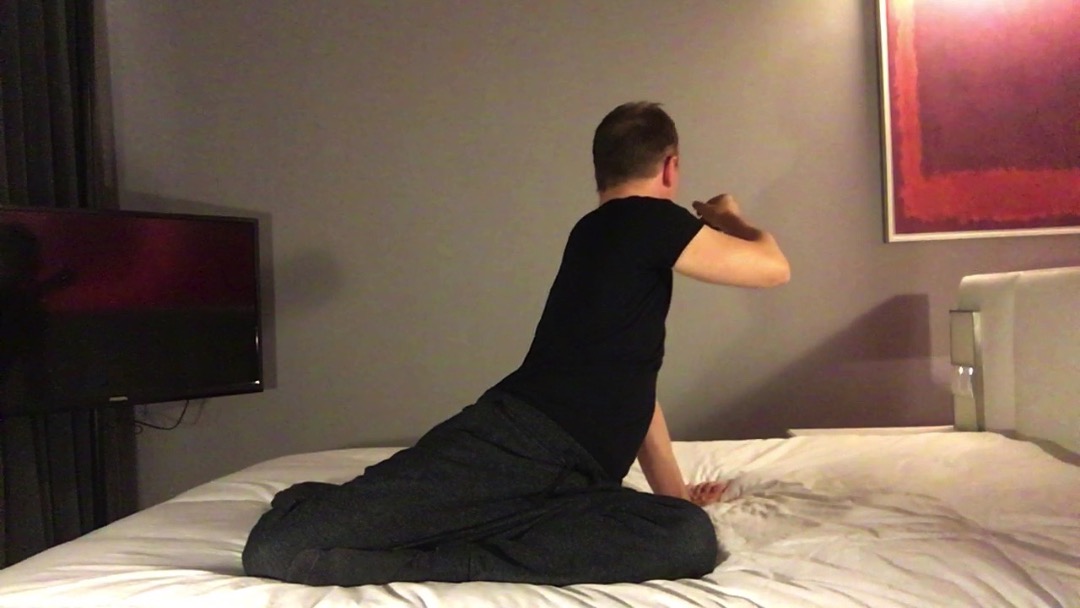
Start position in side-sitting, facing the wall in front of you, with closed eyes
Reference movement
Turn left in the lightest way
With your eyes closed, and your hand in front of your face, turn to the left. See how far you go.
- Then lie on your back and take a rest again.
Reference movement
Turn left in the lightest way
With your eyes closed, and your hand in front of your face, turn to the left. See how far you go.
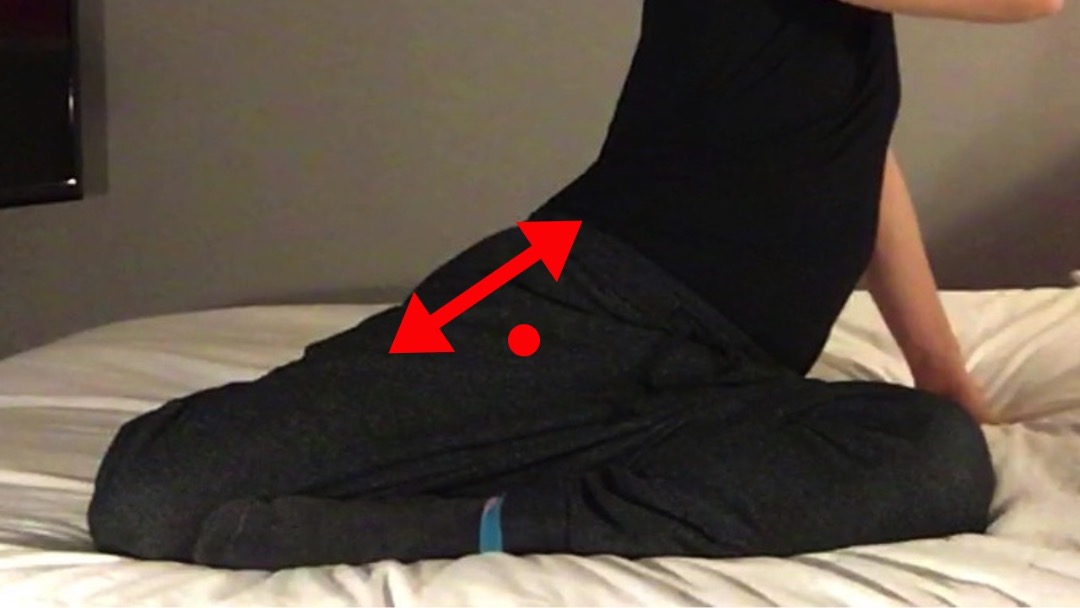
Start position in side-sitting, facing the wall in front of you
Turn left, notice right hip joint
While you turn back and forth notice your right hip joint lifting and lowering from and to the floor.
- Do very small movements, starting from either end of your movement range. Experiment and play with the differentiating movements of your head and eyes.
Also notice the pressure on your left ischium increasing and decreasing while you turn.
Turn left, notice right hip joint
While you turn back and forth notice your right hip joint lifting and lowering from and to the floor.

Start position in side-sitting, facing the wall in front of you, with closed eyes
Reference movement
Turn left in the lightest way
With your eyes closed, and your hand in front of your face, turn to the left. See how far you go.
- Then lie on your back and take a rest again.
Reference movement
Turn left in the lightest way
With your eyes closed, and your hand in front of your face, turn to the left. See how far you go.
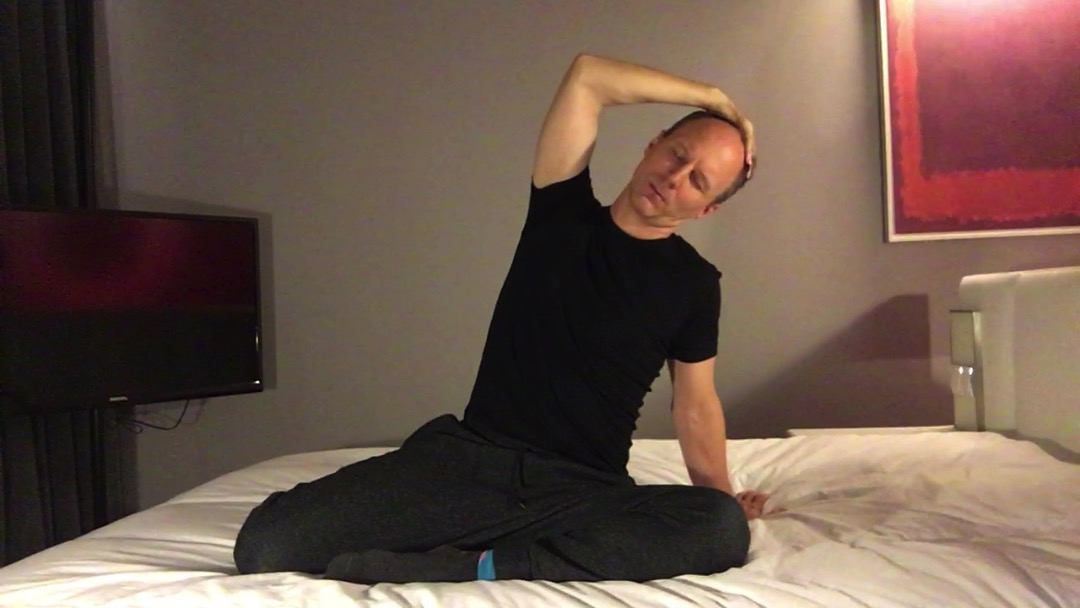
Seated twist to the left, at the reference point. Left hand is on the floor behind you, not to the left. Right palm on the top of your head.
Tilt head to the left
Help with your right hand to navigate your left ear towards your left shoulder.
- Do not turn your head. Notice the change of pressure on your left and right ischium: the left gets lighter while the right moves downwards.
Tilt your head to the left and help with your whole torso, your whole body, your ribs on your sides come closer and further away from each other.
Tilt head to the left
Help with your right hand to navigate your left ear towards your left shoulder.
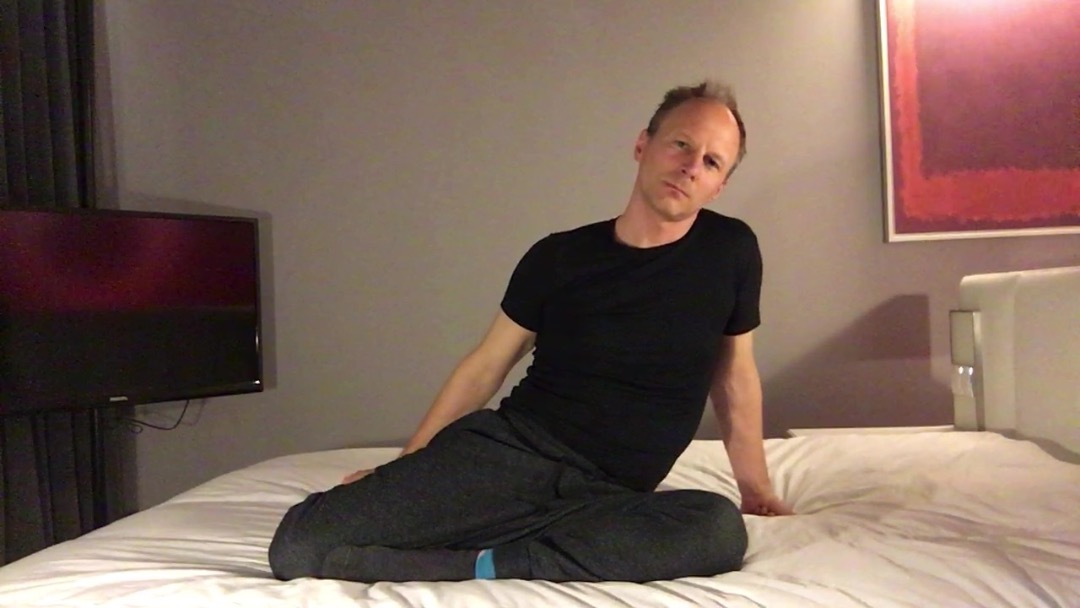
Seated twist to the left, at the reference point. Left hand is on the floor behind you, not to the left. Right palm on the top of your head.
Continuation
Left shoulder towards left ear
Reverse the previous movement by bringing your left shoulder towards your left ear instead of the other way round.
- Move the left shoulder and keep the head in place. This is a change in movement initiation, one of the key concepts of lessons of somatic education.
Continuation
Left shoulder towards left ear
Reverse the previous movement by bringing your left shoulder towards your left ear instead of the other way round.
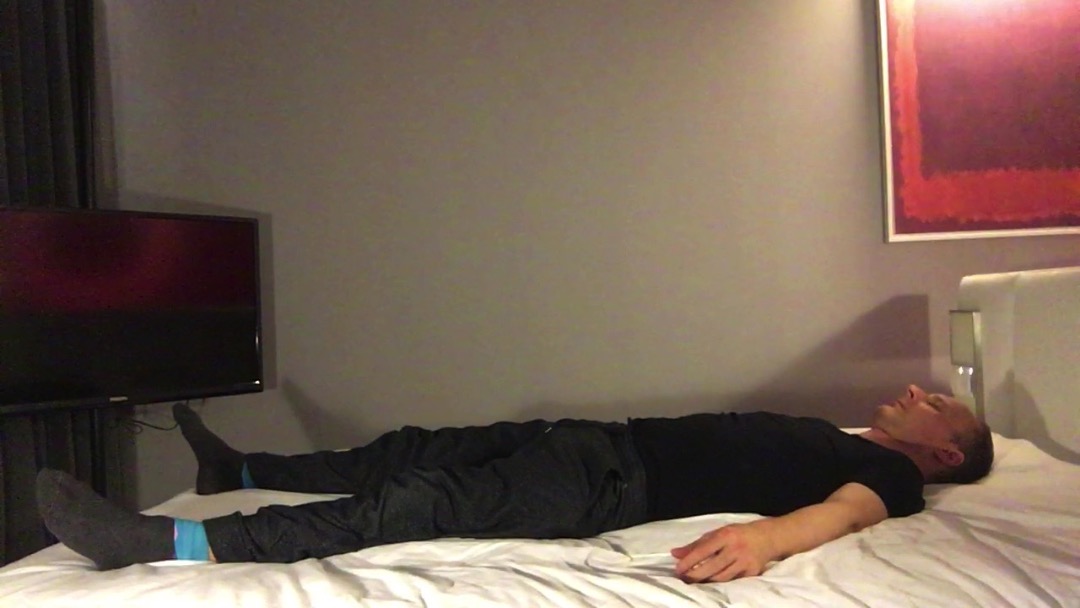
Supine, on your back
Take a rest
Where can you feel the change?
- You will find that there are changes in the heels, they lie differently. Also, the calf muscles lie differently and the back of the knees lie differently and the hip joints are different and the shoulders and the chest is different and even the head and the eyes. The head lies differently on the floor than before.
Take a rest
Where can you feel the change?
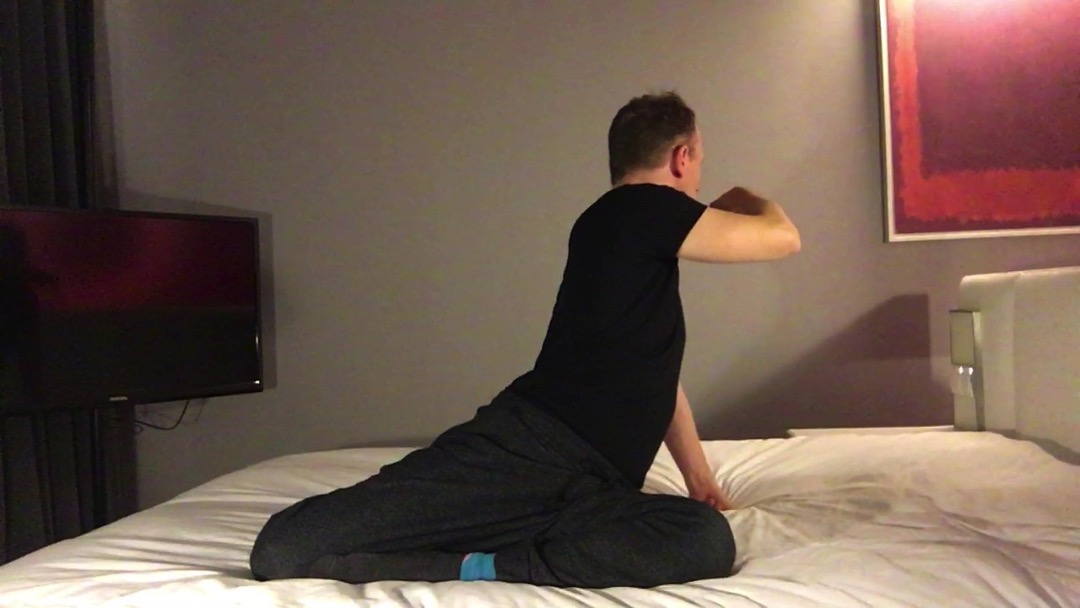
Start position in side-sitting, facing the wall in front of you, with closed eyes
Reference movement
Turn left in the lightest way
With your eyes closed, and your hand in front of your face, turn to the left. See how far you go.
Reference movement
Turn left in the lightest way
With your eyes closed, and your hand in front of your face, turn to the left. See how far you go.
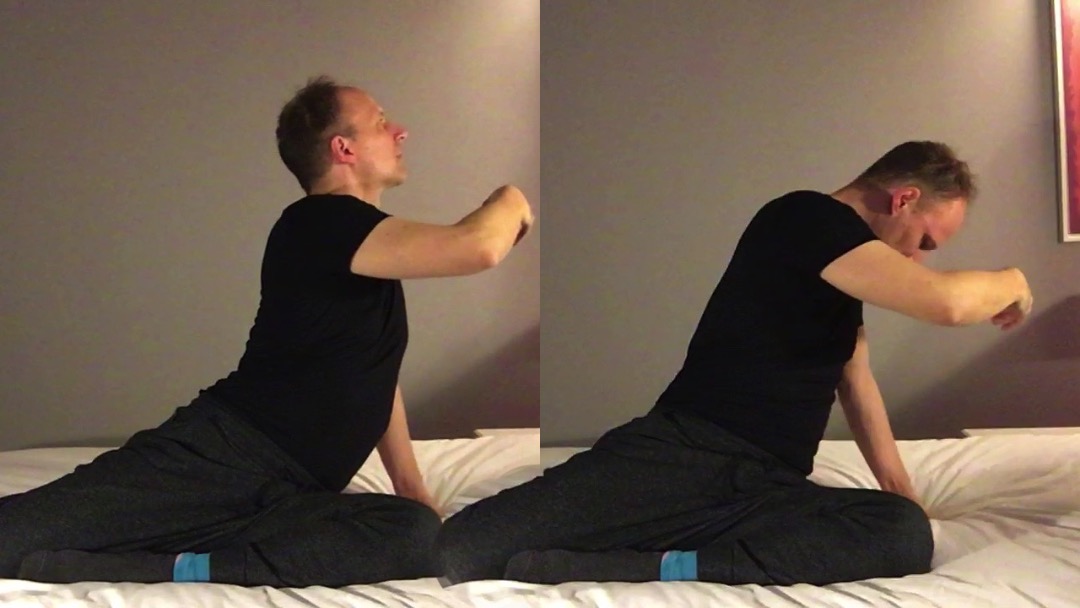
Seated twist to the left, at the reference point.
Lower and lift head
Bend down and arch up, involve everything that was previously discussed.
- Don't overarch, but think of finding length. Involve your right hip joint, and both ischium. Feel your knees on the floor.
Push your lower abdomen out when you lift your head, and bring your head down as to kiss your knee when you lower your head.
Lower and lift head
Bend down and arch up, involve everything that was previously discussed.
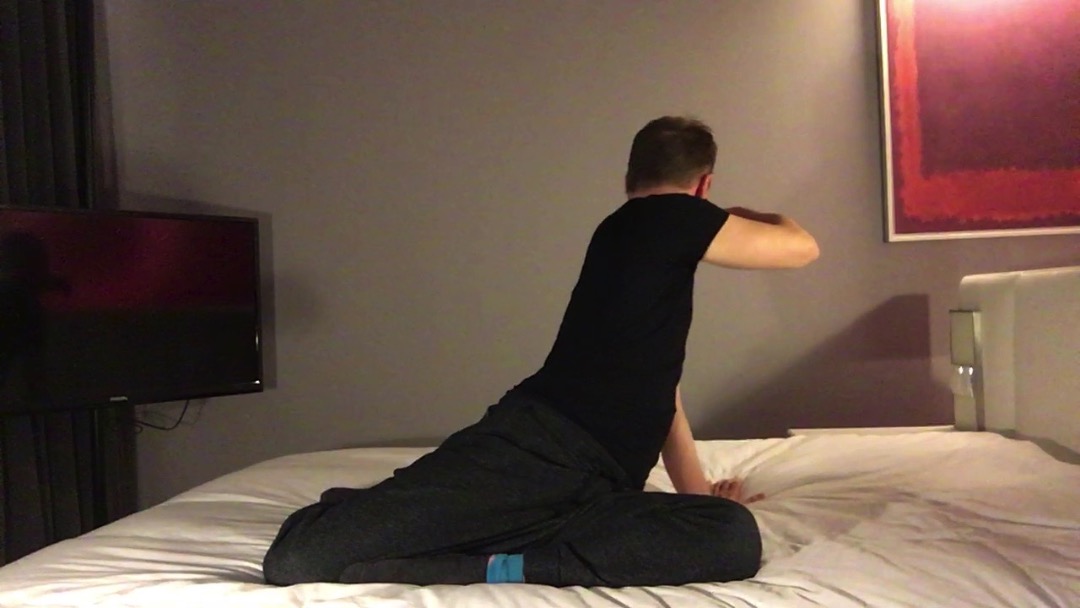
Start position in side-sitting, facing the wall in front of you, with closed eyes
Reference movement
Turn left in the lightest way
With your eyes closed, and your hand in front of your face, turn to the left. See how far you go.
Reference movement
Turn left in the lightest way
With your eyes closed, and your hand in front of your face, turn to the left. See how far you go.
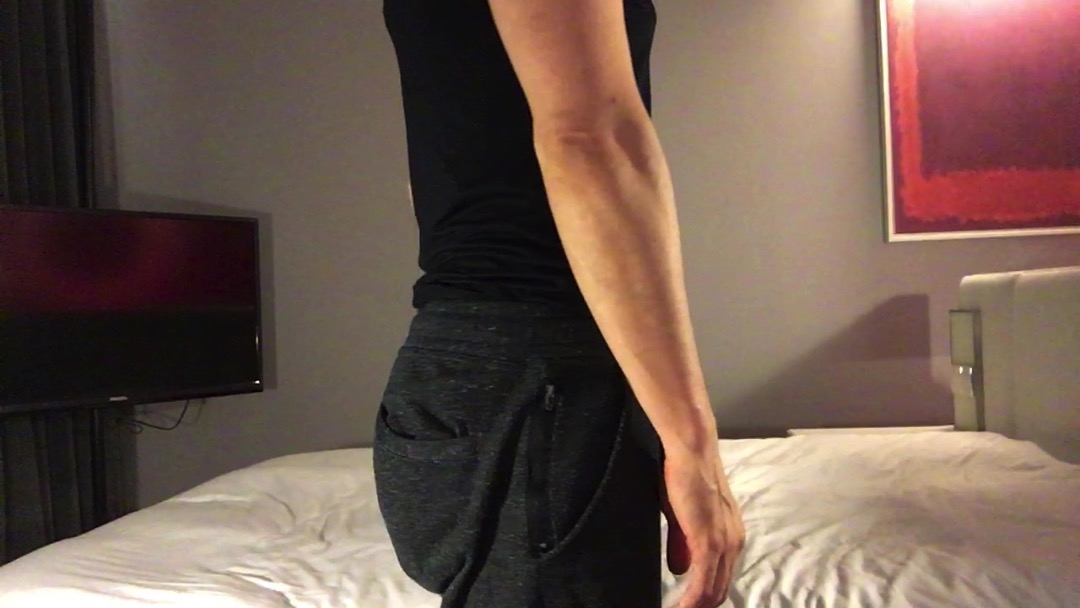
In standing
Stand
Come up to standing and see how it is.
- Do you feel taller, smaller? How is the right side compared to the left? Is the right foot on the floor with the same pressure as the left? Is there a bias in the pelvis to stand on one leg easier than on the other? Is the face the same, does it feel the same on the right and the left side? Your smile ... does the corner of your mouth on the right side feel the same as on the left? Is one arm longer than the other?
Stand
Come up to standing and see how it is.

